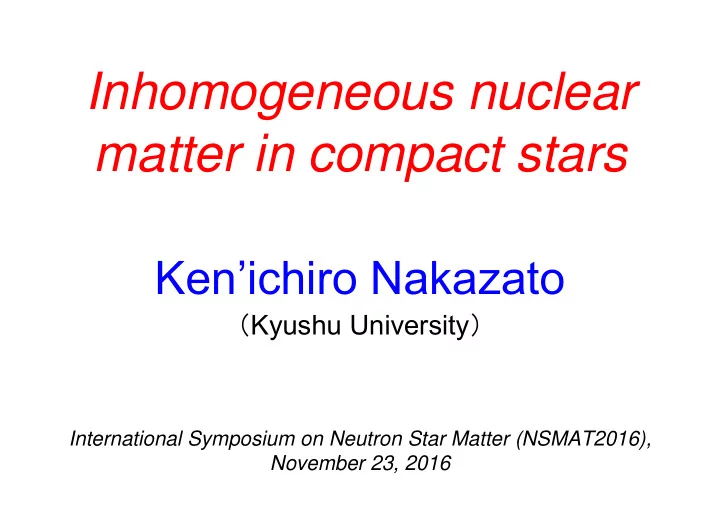

Inhomogeneous nuclear matter in compact stars Ken’ichiro Nakazato ( Kyushu University ) International Symposium on Neutron Star Matter (NSMAT2016), November 23, 2016
Compact stars Supernova core core collapse supernova Proto-neutron star ( PNS ) Neutron star ( NS ) or quark star??
Interior of neutron star • Static structure of nuclear matter at T = 0. core ( uniform ) n Y? p crust ( inhomogeneous ) n e A
Supernova core • Nuclear matter is compressed due to stellar collapse. n 0 : nuclear density ~ 3 × 10 14 g/cm 3 matter density 0.1 n 0 0.01 n 0 n 0 uniform matter clusters of neutron nucleons ? ( nuclei ) proton
Nuclear pasta • “Nuclei” deform at subnuclear densities. Figure by K. Oyamatsu ( 1993 ) spaghetti lasagna meat ball uniform matter “Nuclei” macaroni Swiss cheese density ↗ “Hole nuclei”
Analogy with polymer shapes • A complex structure ( gyroid ) is discovered experimentally between cylinder and slab. f A ↗ T f A Phys. Today 52 , No.2, 32 (1999)
Liquid-drop approach to gyroid c.f., Nakazato et al., PRL 103 (2009) 132501. single gyroid Nakazato et al., PRC 83 (2011) 065811. Y p = 0.3 double gyroid u • They are not the energy-minimum phase for any volume fraction u . • Energy of double gyroid is lower.
Hartree-Fock result for gyroid Schuetrumpf et al., PRC 91 (2015) 025801 single gyroid binding energy ( MeV ) • Double gyroid is unstable but single gyroid would exist as metastable state in proto-neutron stars.
Proto-neutron star • Proto-neutron star ( PNS ) is nascent neutron star formed just after the supernova. → System of nuclear matter with finite T . • It is cooled by neutrino emission. → Interaction in inhomogeneous phase. T ~ MeV high density low density Supernova inner outer A inhomogeneous uniform
Equation of state at finite T Fischer+ (2011) • Nuclear physics at 0.5 100 finite T is needed for proton fraction Y p studies of supernova T ( MeV ) and PNS evolution. → Table of equation PNS of state ( EOS ) . cooling 0.01 0 10 6 B ( g/cm 3 ) 10 14 inhomogeneous @ T = 0 Y p T NS EOS Y p B B
New nuclear EOS table Togashi et al., submitted • Popular EOS tables: – Lattimer & Swesty (1991) Y p = 0.5 – Shen et al. (1998) → phenomenological • New EOS table. based on realistic nuclear force. – Togashi & Takano (2013) inhomogeneous inhomogeneous phase with Thomas-Fermi Y p = 0.01 approach. – Oyamatsu (1993)
Comparison at T = 0 • Difference in neutron matter ( Y p = 0 ) EOS. – seen in symmetry energy E sym and gradient L . E / N [MeV] New EOS ( Variatinal ) Variational Shen EOS E sym = 30 MeV Y p = 0 L = 35 MeV E sym Shen EOS Y p = 0.5 E sym = 37 MeV L = 111 MeV n B [fm -3 ]
Inhomogeneous matter in PNS • New EOS has wider inhomogeneous phase and larger mass number of nuclei. – because of smaller symmetry gradient L . PNS profile of 7s after the bounce, model from Nakazato et al. (2013) New EOS Inhomogeneous Shen EOS inner region outer region
Summary • Inhomogeneous phase appears in compact stars at subnuclear densities, e.g. NS crust. • In proto-neutron stars ( PNS ) , pasta nuclei are likely to appear, even for metastable gyroid. • For studies of supernova and PNS, equation of state ( EOS ) including inhomogeneous at finite temperatures is needed. A new EOS table has been constructed! • Role of nuclear physics in NS crust. → stay tuned for next Sotani-san’s talk.
Recommend
More recommend